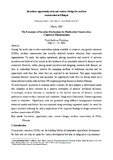| dc.contributor.author | Wale, E | |
| dc.contributor.author | Mburu, J | |
| dc.contributor.author | Virchow, D | |
| dc.date.accessioned | 2013-07-25T06:23:40Z | |
| dc.date.available | 2013-07-25T06:23:40Z | |
| dc.date.issued | 2003 | |
| dc.identifier.citation | Wale E., J. Mburu and Virchow D. (2003). Incentives, Opportunity Costs and Contract Design for On-farm Conservation in Ethiopia. Paper presented at the Third BioEcon Workshop, ‘Contracts and Incentive Mechanisms for Biodiversity Conservation’, 22-25 May, Montpellier, France. | en |
| dc.identifier.uri | http://www.google.com/url?sa=t&rct=j&q=&esrc=s&source=web&cd=3&ved=0CDUQFjAC&url=http%3A%2F%2Fwww.bioecon-network.org%2Fpages%2F3rd_2003%2FWale.pdf&ei=oMHwUaPmH8GS7Qac5IDAAw&usg=AFQjCNFAeiB3AQpnT8EuZ7wty3hpEDUYVw&bvm=bv.49784469,d.ZGU | |
| dc.identifier.uri | http://hdl.handle.net/11295/50855 | |
| dc.description.abstract | Among the in-situ and ex-situ conservation options available to conserve crop genetic resources
(CGRs), on-farm conservation has recently attracted massive attention from concerned
organizations. To make this option operational, placing incentives and removal of perverse
incentives are believed to be crucial so that landraces of no immediate interest to farmers can be
conserved. However, before placing sound incentives and designing contracts with farmers, we
have to understand farmers’ motives for managing portfolio of traditional varieties and the
opportunity costs they face when they are expected to use landraces. This paper empirically
examines farmers’ incentives and generates the opportunity costs they are facing based on a
household survey data collected from 198 sorghum growing farmers in Eastern Ethiopia.
To study farmers’ incentives to maintain native varieties, we have adopted a utility-based model
that considers on-farm diversity as a positive externality of farmers’ livelihood decisions.
Accordingly, on-farm diversity is considered as the derived outcome of farmers’ revealed
preferences subject to their concerns and constraints. Using such a framework, Poisson regression
model is estimated. Opportunity costs are generated using different homogeneous treatment
statistical models and further they are examined using switching regression model. As usual the
paper concludes outlining the policy implications of the empirical findings to design contracts for
on-farm conservation of CGRs. | en |
| dc.language.iso | en | en |
| dc.title | Incentives, Opportunity Costs and Contract Design for On-farm Conservation in Ethiopia | en |
| dc.type | Presentation | en |

